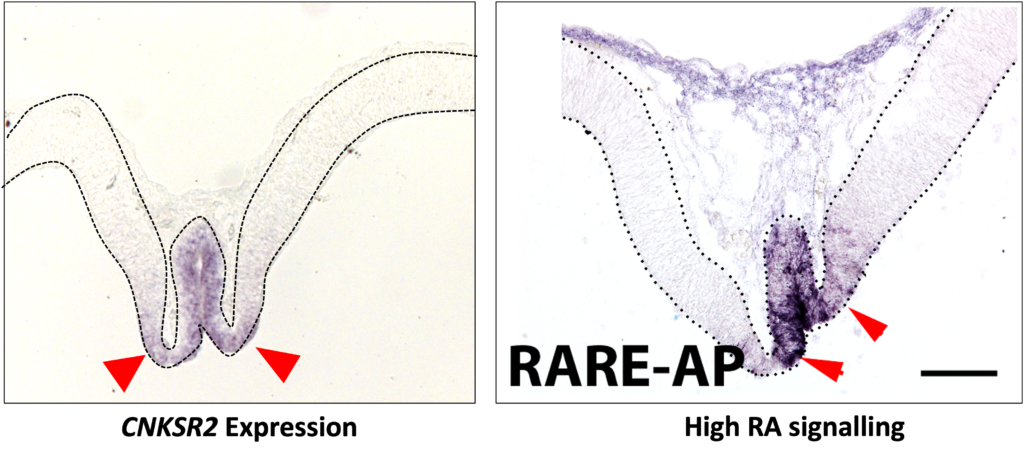My first foray into developmental biology came during my undergraduate Zoology class in 2013. The class was on the famous Spemann-Mangold Organizer, and I remember that I found the class quite interesting. After my Masters, as any student at that stage would do, I started applying for PhD programs. I appeared for interviews at numerous institutions, and finally got an offer from IIT Kanpur in the lab of Prof. Jonaki Sen. Her research group works on understanding nervous system development using the chick embryo and mouse as a model system.
At first, I was apprehensive to take on the offer as I had little knowledge about the techniques used in the lab and Developmental Biology in general. However, Prof. Jonaki assured me that I would be alright and learning the techniques would not be difficult. Not one to shy away from challenges, I joined her lab in the summer of 2015 As I shadowed my senior colleagues, I found that I was able to grasp the techniques quite easily, but it required a lot of practice to perfect it. I started to enjoy working in the lab. A study done by Prof. Amitabha Bandyopadhyay’s group had resulted in generation of a database of the expression patterns of Metabolism-Related Genes (MRGs) in the chick embryo. My thesis was inspired by this study and was aimed at exploring the functional roles of some of the MRGs in the brain of the chick embryo.
To completely understand my PhD work, I would need to explain how the vertebrate nervous system develops. During development, a single brain vesicle separates into two compartments. The compartments form the hemispheres of the brain. If this separation is hampered, then a serious developmental brain disorder known as holoprosencephaly occurs. A previous study from our lab led by Dr Sandeep Gupta showed that retinoic acid (RA) signalling is one of the major regulators of formation of the cerebral hemispheres in the embryonic chick brain.
I started my doctoral thesis by first screening for precise expression profiles of the MRGs in the chick forebrain. It was at this point that I found a gene known as Connector Enhancer Kinase Suppressor of Ras 2(CNKSR2) to be expressed in the same region where RA signaling was reported to be present by Dr Sandeep Gupta. Therefore, we hypothesized that CNKSR2 could be a new downstream target of RA signaling in the chick forebrain. Our experiments showed that this was indeed the case, and that CNKSR2 is involved in crucial events during cerebral hemisphere formation such that its absence can seriously hamper this process and lead to a condition very similar to holoprosencephaly.

Although, I can now summarize my findings in one paragraph – my PhD journey was a rollercoaster ride filled with moments of excitement and failures. The exciting moments especially after months of failed experiments have reminded me of the proverb “Tough journeys often lead to the best views.” The frustrations have made me a more patient and a resilient person. I am thankful to Prof. Jonaki Sen and Prof. Amitabha Bandyopadhyay for believing and bringing out the best in me. I am equally indebted to the past and present members of Sen (S) and Bandyopadhyay (B) (SB Lab!) for making me the scientist I am today. Every member has helped me in some way or the other such that my research work could get published in a timely manner. The SB lab believes that research carried out in our groups should reach the general public. Prof. Bandyopadhyay suggested the idea of making multi-lingual videos in regional/known languages explaining our research. We have attempted to do so and made videos in English, Hindi, Tamil, Bengali and Nepali, that can be found on BSBE IITK twitter handle (@BSBEIITK1) and on YouTube (https://www.youtube.com/watch?v=DYqUZj_2GWc&list=PLfuW2AStgVgCKzsOHqAfc18u58dCuAhKJ&ab_channel=BSBEIITK)
In March 2023, I defended my PhD thesis, and I am currently a Postdoctoral Fellow in the lab of Dr Shannon McKinney-Freeman at St Jude Children’s Research Hospital in Memphis, Tennessee looking to unravel the mysteries of hematopoiesis.
References:
1) Udaykumar N, Zaidi MAA, Rai A, Sen J. CNKSR2, a downstream mediator of retinoic acid signaling, modulates the Ras/Raf/MEK pathway to regulate patterning and invagination of the chick forebrain roof plate. Development. 2023 Feb 15;150(3):dev200857. doi: 10.1242/dev.200857. Epub 2023 Feb 3. PMID: 36734326.
2) Gupta S, Sen J. Retinoic acid signaling regulates development of the dorsal forebrain midline and the choroid plexus in the chick. Development. 2015 Apr 1;142(7):1293-8. doi: 10.1242/dev.122390. Epub 2015 Mar 10. PMID: 25758461.





